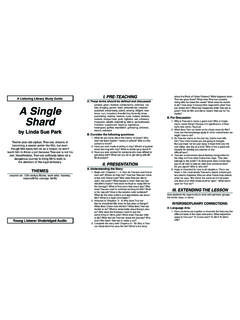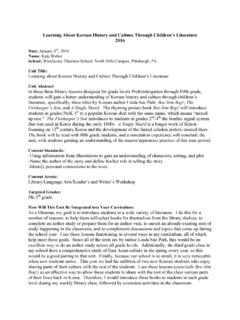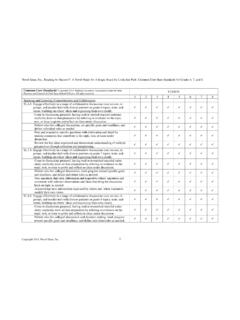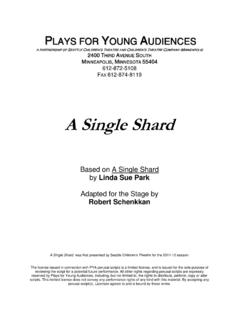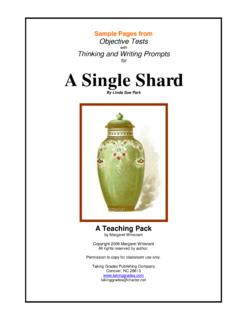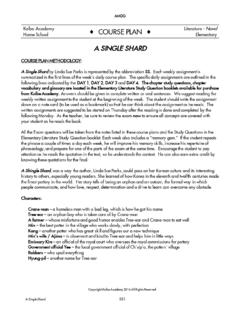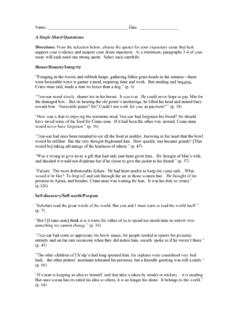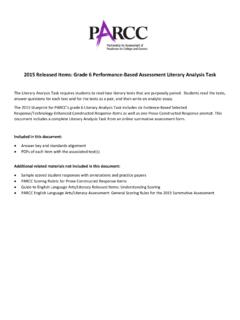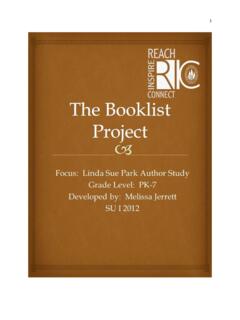Transcription of Lesson Title: A Single Shard Class and Grade level(s)
1 Lesson Title: A Single Shard Class and Grade level(s): 6th Grade Social Studies Goals and Objectives Students will be able to: 1. Synthesize what is read and heard into a well-crafted product on Korean culture. 2. Do primary and secondary source research about Korean culture. 3. Participate in discussions about A Single Shard and life in 12th-century Korea. Time required/ Class periods needed: 12-15 Class periods Primary source bibliography: Korean History: Hidden Korea: Linda Sue Park Website: Other resources used: Park, Linda Sue. A Single Shard . New York: Scholastic, Inc. 2002. Required materials/supplies: o Copies of A Single Shard o Response journal o Copies of response journal and other handouts (below). o Display boards Vocabulary: celadon monk temple filial piety inlay Mongols T'ang jiggeh derision spoor frenzied felicitous tedious tithe royal emissary vessels harangued exalted entourage tumultuous endeavor trepidation quell wasters calligraphy Procedure: 1. Introduce unit by asking the essential questions: What is culture?
2 How do you know what's of value to a culture? 2. Locate Korea on a map of Asia 3. Learn about celadon pottery: images can be found at 4. Explore and discuss the culture and geography of Korea using the website 5. Read A Single Shard . Students will keep a response journal as they read each chapter. Responses will relate to the comprehension of the novel and culture. 6. Using prompt belwo, students will research an element of Korean culture. The findings of their research will be displayed in the classroom as museum exhibits. Assessment/evaluation: Students will be assessed on the following: o Evaluation of museum exhibit using a 4-point rubric o Response journals o Vocabulary quizzes Response Journal Rubric 4 Beyond Expectations Answer is correct and shows understanding beyond what is expected. Sentences/definitions are spelled and punctuated correctly. 3 Meets Expectations Answer is correct. Sentences/definitions are spelled and punctuated correctly. 2 Needs Improvement Answer is not complete.
3 Sentences/definitions have an error. 1 Does Not Meet Answer is incorrect. Expectations Sentences/definitions have 2 or more errors. Culture: Culture is a way of life of a group of people including the practices, beliefs, values, and symbols that they accept (generally without thinking about them) and that are passed along by communication and imitiation from one generation to the next. Make a list of practices, beliefs, values and symbols: _____. _____. _____. _____. _____. _____. _____. _____. _____. _____. _____. _____. _____. _____. _____. _____. _____. _____. _____. _____. _____. _____. _____. _____. _____. _____. _____. _____. _____. _____. Chapter 1. This chapter introduces the characters Tree-ear, Crane-man and Min. Describe Crane-man. _____. _____. _____. _____. Describe Tree-ear. _____. _____. _____. _____. What do they do to get food? _____. _____. Where do they live? _____. _____. Why do they live there? _____. _____. Who is Min? _____. _____. Why is the village of Ch'ulp'o important?
4 _____. _____. Define the following words: jiggeh (p. 4). _____. monk (p. 9). _____. Chapter 2. Tree-ear says to Min, I would not steal. Stealing and begging make a man no better than a dog. What does this sentence mean? _____. _____. _____. _____. _____. It took Min 3 days to make the box that Tree-ear damaged. Min demands 9 days of work for repayment. Is it a fair deal? Justify your answer. _____. _____. _____. _____. _____. Define the following words: filial piety (p. 17). _____. derision (p. 18). _____. Chapter 3. Finish the character web about Min. Define the following words: spoor (p. 27). _____. frenzied (p. 27). _____. Chapter 4. What is a royal commission? _____. _____. How does a royal commission benefit a potter? _____. _____. _____. _____. _____. Define the following words: felicitous (p. 41). _____. tedious (p. 41). _____. kimchee (p. 41). _____. bean curd (p. 41). _____. Chapter 5. Is it appropriate to give away a gift that is meant for you? Explain your answer. _____.
5 _____. _____. _____. _____. Think about Tree-ear's character traits up to this point in the book. Do you think it fits into Tree-ear's character to spy on Kang? Explain your answer. _____. _____. _____. _____. _____. Define the following words: tithe (p. 54). _____. midstride (p. 58). _____. Chapter 6. Describe 3 ways that Crane-man is important to Tree-ear. 1. _____. _____. _____. 2. _____. _____. _____. 3. _____. _____. _____. What makes Min's pottery superior to Kang's? _____. _____. _____. _____. _____. Define the following words: vessels (p. 66). _____. inlay (p. 71). _____. Chapter 7. Why was Min in such a bad mood at the beginning of the chapter? _____. _____. _____. _____. _____. What is the Korean cultural view of foxes? Why? _____. _____. _____. _____. _____. Define the following words: harangued (p. 73). _____. exulted (p. 77). _____. Chapter 8. Min refused to teach Tree-ear to make a pot. Why? _____. _____. _____. _____. _____. Define the following words: entourage (p.)
6 89). _____. tumultuous (p. 89). _____. Chapter 9. Crane-man and Tree-ear are not related. Do you consider them a family? Why or why not? Explain your answer. _____. _____. _____. _____. _____. Define the following words: feigned (p. 96). _____. endeavor (p. 100). _____. Chapter 10. Koreans are superstitious of foxes. What are some modern superstitions? _____. _____. _____. _____. _____. Compare and contrast the village of Ch'ulp'o to Puyo. _____. _____. _____. _____. _____. Define the following words: trepidation (p. 109). _____. Mongols (p. 115). _____. T'ang (p. 115). Chapter 11. Tree-ear was robbed on his journey. Should Min have let him go on such a dangerous mission? Why or why not? _____. _____. _____. _____. _____. Think of an adjective that describes how Tree-ear felt when the vases were thrown over the cliff. Describe a time when you felt the same way. _____. _____. _____. _____. _____. Define the following words: quell (p. 121). _____. pallor (p. 122). _____. Chapter 12.
7 How could the royal emissary for pottery ware bestow a royal commission by just looking at a Shard ? _____. _____. _____. _____. _____. Define the following words: wasters (p. 135). _____. calligraphy ( ). _____. Chapter 13. Earlier in the book, Min said he woulr never teach Tree-ear to be a potter. Write about three events in the book that helped to change Min's mind. _____. _____. _____. _____. _____. Define the following words: surreptitiously (p. 142). _____. spare (p. 144). _____. Welcome to Korea Task: You are opening a new museum on Korean culture designed to engage and inform young people. Your task is to select an element of Korean culture, research it and construct an exhibit. The exhibit may include pictures, artifacts, or both and a written explanation about the display. Your explaination must include a thorough description of the display using the 5 Ws and its value to the culture.
